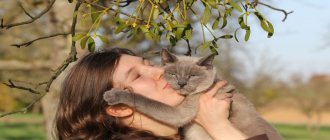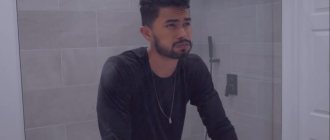Why are animals afraid of people?
Konrad Lorenz once expressed an interesting opinion on this issue. After many years of research, he came to the following conclusion: the more advanced predators are “armed” (with teeth, claws, sharp vision, etc.), the more developed their morality, oddly enough. Strong animals do not finish off their opponents in intraspecific skirmishes if they demonstrate submissiveness.
The weak, on the contrary: the worse they are armed, the more aggressive they are. The little dog barks louder and more fiercely, and if the opportunity arises, he will definitely bite. A lion in a skirmish with a contender for his place in the pride never kills his opponent. Even the most brutal fight ends as soon as the last one retreats and leaves the foreign territory in disgrace.
Man in this regard is a paradox. According to natural data, it clearly belongs to the weak species. He has no frightening fangs, no claws, no armor, but progress has given him a strong trump card - a firearm. With its help, people migrated from the category of the weak to the elite army of strong “predators”.
The paradox is that human morality has not grown at all. Homo sapiens still continues to kill hunted, exhausted and wounded animals. And he often does this not because he is hungry, but simply for fun. This behavior is abnormal for the animal world, so humans seem to animals to be the most dangerous and unpredictable predator.
Over centuries of progressive human activity, only species that learned this lesson were able to survive. The rest are now included in the Red Book of endangered or already extinct animals due to the fault of people.
Types of pathology
Hypertrichophobia, although called a fear of hair, is actually not exactly what it is. This fear is a type of phobia called trichophobia.
It is trichophobia that characterizes a person who is afraid of the sight of hair, getting it into food or on any other object. Two pathologies are distinguished from this disease:
- chaetophobia - fear of unwashed hair;
- hypertrichophobia - fear of the sprouting of new hair on the body.
But often these pathologies are combined into one concept - hypertrichophobia.
Recently, another branch of the disease has been noted - the fear of finding someone else's hair on one's clothes. Fear of hair can be caused by many reasons, especially in childhood. An adult does not notice many small annoying details, while a child notices a lot. For example, the sight of falling hair in a hairdresser can later turn into a real disaster for a child, becoming the foundation for the accumulation of irrational fear.
An adult can acquire such a phobia when eating food that contains hair. Hypertrichophobes are afraid of swallowing hair, so eating turns into torture for them. He is busy looking for hairs hidden in food. The cause of hypertrichophobia may also be a fire caused by the ignition of hair on the head. Such stress causes the person possessed by a phobia to shave his hair bald, all over his body.
Hunting
According to the hunters themselves, the fear of wild animals towards people is caused by the activities that they carry out in the forest. In particular, hunting. Deafening rifle shots scare away game with lightning speed.
In addition, animals perfectly “read” even subtle aromas, and after a hunt, the smell of blood, fear and death lingers in the forest for a long time. The instinct of self-preservation forces four-legged and feathered animals to do their best to avoid the danger that is associated with it.
Do not underestimate the memory and intelligence of our smaller brothers. Boars, foxes, deer and other forest inhabitants perfectly remember the sounds and aromas that accompany the hunt.
The smells of people remain etched in their memory for a long time, no matter how hard they try to disguise themselves. For this reason, experienced hunters always position themselves downwind of the game. This way the animal will not smell the human scent and will not disappear prematurely.
Treatment options
When the first symptoms of a panic attack appear, there is a natural desire to suppress them with the help of sedatives. But this is the wrong way. In this way, this disorder is not cured, but only worsens.
It is important to understand the causes of the phobia. You can't do it without a psychotherapist
Depending on the severity of the phobia and individual psychological characteristics, the following is used:
- relaxation and meditation techniques - will teach you how to relax and control your body, thoughts, feelings;
- autogenic training - will help relieve panic and calm down;
- Cognitive behavioral therapy, which helps change your attitude towards a situation.
It is important to distinguish manifestations of fear of sudden movements from other psychological disorders and mental illnesses. Similar symptoms are characteristic of the initial stage of schizophrenia, hysterical disorders
If adequate treatment is delayed for any reason, the phobia begins to progress. First of all, the sphere of professional activity suffers. The person loses his job and withdraws into himself. Any contacts are gradually reduced to a minimum. To justify inaction, ergasiophobes complain of incomprehensible pain and chronic fatigue. Moreover, a health check does not reveal any special problems.
It is very important not to start treatment for ergasiophobia. Trying to solve the problem on your own will not bring results.
It is important to contact a specialist in time, who will prescribe individual therapy and return you to a full life.
Causes of hypnophobia
Many psychotherapists note that, to some extent, the fear of falling asleep is genetically embedded in us - a kind of ancestral memory. When falling asleep, a person loses control over what is happening around him and becomes defenseless. And before this was critical for survival - while sleeping, a person could be attacked by a predator or enemies. A guard who fell asleep at his post could well lead to the death of the entire tribe. For some people, the echoes of this ancient fear are stronger than for others, creating the preconditions for the emergence of a phobia.
The causes of fear differ between adults and children, although there are common factors.
Causes of fear of sleep in children
It is worth mentioning separately hypnophobes, whose fear of sleep is a fear of wasting time. It occurs in people overloaded with work, family responsibilities, business affairs, who always lack the “25th hour in the day.”
Treatment of psychological disorder
Before making a decision on treatment, you should understand whether a person needs it?
Oddly enough, for many people, hedonophobia is a way of life that suits them and brings them complete satisfaction. By avoiding happiness, such individuals feel safer and... happier. If hedonophobia does not interfere with a person's quality of life or abilities, they are unlikely to need treatment. Rather, on the contrary, intervention will only harm the usual way of life. If a person who is capable of rejoicing and enjoying life in all its glory suddenly loses interest in its delights, then he should be closely monitored. If you notice symptoms of hedonophobia, you should immediately consult a psychotherapist. This specialist will help with the initial stage of the disease, but if the phobia has developed into a more severe state, then a consultation with a psychiatrist will be required.
To date, there are no widely used treatments for hedonophobia. The most commonly used treatments for such patients are hypnotherapy or cognitive behavioral therapy. The latter helps a person recognize faulty lines of thinking and identify behaviors that will help change personal relaxation strategies.
Features of the origin of hair phobia
Experts believe that the foundations for a fear of hair are laid in childhood. Children at different stages of their development are sensitive and receptive to both real and mystical fears. They are subject to vivid emotional reactions not only to events that they see with their own eyes, but also to all kinds of stories. Therefore, there are several theories about the origin of hypertrichophobia:
- Real. Experiencing unpleasant sensations when coming into contact with cut hair, expressed in its causticity or skin irritation. Hair getting into the mouth, on clothes, food, eyelash loss - all this serves as a real reason for discomfort and fear.
- Far-fetched. It is associated with the appearance of disgust and disgust, which gradually develop into a phobia: for example, the sight of hair in the sink or its burning smell. With age, many people stop taking care of the condition of their hair; it becomes dirty and greasy. Therefore, a person has an image of unwashed hair, associated with the approach of death.
- Mythological - for example, children's fairy tales, which tell that a swallowed hair will turn into a worm and begin to devour a person from the inside. Such stories may well play a role in the emergence of a phobia. It should be noted that hair is not digested in the stomach, threatening the occurrence of appendicitis.
For a person who is afraid of hair, going to catering establishments or a hairdresser turns into torture. Due to the fear of being ridiculed by those around him, the symptoms of the disease are clearly manifested, therefore, like any mental illness, hypertrichophobia requires treatment.
Symptoms of the disease
The disease manifests itself with certain symptoms. Thus, a person suffering from genuphobia is distinguished by the following:
- he never wears skirts, dresses or shorts above the knee;
- does not visit beaches and swimming pools;
- cannot calmly touch his own kneecaps;
- he is disturbed by the appearance of other people's bare knees.
The symptoms of this disease are very diverse. So, when seeing knees, a person may experience:
- attack of sudden fear;
- a sharp increase in blood pressure;
- increased heart rate;
- feeling of unreality.
Scientists still have not figured out what exactly this disease is associated with. It is reliably known that young women are more susceptible to this phobia. If a person regularly thinks about his own knees and wants to change their shape with the help of plastic surgery, then this is a serious reason to consult a psychotherapist.
Interesting fact! The famous TV presenter and former participant in the TV project House 2 changed the shape of her knees. According to the girl herself, since adolescence she dreamed of having a beautifully shaped kneecap. And as soon as the financial opportunity arose, she had plastic surgery and corrected the shape of her knees, making them sharper.
How to get rid of zoophobia yourself
If you have an anxiety-phobic disorder, self-medication is highly not recommended: the help of a qualified specialist is necessary. However, the following recommendations will help you significantly reduce anxiety on your own. This practice is carried out in three stages:
- Modeling.
The first stage is aimed at modeling dangerous situations and “living” them in your own imagination. For example, if you are afraid of dogs, imagine a huge dog running towards you. Then allow yourself to experience all the most negative emotions and fears, all your fears: give free rein to your feelings. Modeling must be carried out until, at the level of imagination, the fear experienced weakens.
- Meeting with the object of a phobia.
After going through the modeling stage, you can begin communicating with the object of your phobia. Communicate with your dog through a crate or glass. Let her be muzzled and on a strong chain, so that objectively she does not have the opportunity to in any way hurt you. Track your emotions, don’t suppress them, but experience them! By interacting with a fearful animal over and over again at a safe distance, you will notice that your anxiety decreases with each session.
- Direct contact with the object of fear.
Once you feel that you are already relatively calm when contemplating an animal in a cage, you can organize direct contact with the object of fear. Visit a dog park or park. For starters, you can watch the animals from afar. Shorten the distance every day.
This practice is quite difficult to do alone and independently. After all, if for an ordinary person these actions are absolutely simple and easy to perform, then the zoophobe begins to experience panic even at the modeling stage. This is why psychological support from others is so important. This could be a relative or close friend - a positive, psychologically strong person whom you trust. But it’s best if it’s a psychologist.
What other types of zoophobia are there:
- Alektorophobia – fear of chickens;
- Mottephobia – fear of moths;
- Insectophobia – fear of various insects (is a subsection of a large number of phobic disorders)
- Scoleciphobia is the fear of worms.
Forest as an object of fear
Hylophobia refers to specific phobias, its object is the forest. Dendrophobia and xylophobia are often added to the fear of the forest. For some people, trees become a source of anxiety, especially at night. Excessive irrational fear of parks and forest plantations in the dark is called nyctohylophobia.
Main reasons
It is generally accepted that all phobic conditions arise from a combination of external events and psychosomatic predispositions. Many specific phobias can be traced back to their “start.” Usually this is a situation from childhood that traumatized the child. While social phobias and agoraphobia have a more complex mechanism of occurrence, at the moment it is not reliably known.
Fear of the forest, especially at night, is associated with the culture of our ancestors. Ancient people were no longer afraid of trees, but of the wild animals that hid there, as well as other unknown dangers lurking in the forest thickets. Folk and original fairy tales, for example, “Hansel and Gretel”, “Little Red Riding Hood”, contributed to the cultivation of such fear.
Various mystical stories of many ancient cults also add a dangerous flavor to the forest. Plus, at present, forest areas are becoming a haven for socially dangerous individuals. Even one negative episode in the past, for example, a child getting lost or being left alone with trees around, leads to the emergence of hylophobia.
Symptoms of a phobia
The manifestations of any fear vary from person to person in terms of intensity and are based on individual perceptions. Often uncontrolled fear can lead to panic attacks, which are characterized by the following symptoms:
- shallow, rapid breathing, rapid heartbeat;
- dry mouth, sweaty palms;
- the desire to run and hide, cry, scream;
- nausea, dizziness, gastrointestinal disorders.
Coping methods
It is necessary to consult a specialist in cases where fear interferes with work or relationships. The very first and correct treatment is to visit a psychologist or psychiatrist. Doctors will help you understand the problem that causes the phobia, thereby finding a way to overcome it. The most common methods are:
- Hypnotherapy is a therapy that opens a person's subconscious mind in order to change behavior patterns. Not all people are suitable for this type of treatment, because some people consider it wrong for someone else to “penetrate” their thoughts. It should be noted that this method gives fairly quick positive results and is safe.
- NLP (neurolinguistic programming). The words that an individual uses reflect the internal, subconscious perception of his problems. In NLP it is generally accepted that a person's attitude towards things or events in life is, in a sense, a self-fulfilling prophecy. The neurolinguist will analyze every word and phrase the patient uses to describe symptoms and fears. A specialist will identify the problem of perception and help find the root cause of the phobia.
- Energy psychology is a type of therapy that uses various techniques, such as yoga, acupressure, prana, qigong, to teach people simple steps to make changes in their lives. A combination of psychological sessions and influences on certain areas of a person’s skin helps in overcoming fears. At the moment, this method is still controversial, but it also has fans.
Medications are also prescribed, but they are used in severe forms of phobias
It is important to note that pharmaceuticals cannot cure fears; they only temporarily suppress systemic manifestations of anxiety











